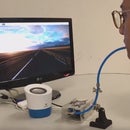Introduction: Sip & Puff Using Raspberry Pi With Google Home
What we are trying to do is to open up the solution to all people with disability to work with us or other Makers, so that they can have a low-cost and effective design. And, can be able to build instantly, so rather than spending thousands of dollars for a commercially available Sip & Puff, the cost can be lower down which much more affordable for patients to support their other expenses.
We wanted to help, so we came up with the design of a device for people with disability to use and experience the power of automation. Our Sip & Puff switch is a breath operated device design to mount to all wheelchairs or desktop bound patient. We want to make our own Sip & Puff as an affordable solution by providing an Open source design using Raspberry Pi with an easy to build and available source of hardware assembly. This device will give people with disability more access in technology and more opportunities in digital connection.
I will post the source code here soon, if you want to add more features for this device you may do so..
Thanks everyone!
Please check out the full video in Youtube:
Step 1: Raspberry Pi & Pressure Sensor
Pressure Sensor Product Overview
The PSF102-7652-710 is a 0.004 to 0.018PSI Pressure Switch with polycarbonate case, polyurethane diaphragm and 0.187 x 0.02-inch spade (recessed) terminals for use with quick disconnects uninsulated. This switch is field adjustable set point from 0.1-inch H2O to 25PSI. World Magnetics exclusive Design Flex™ feature allows to quickly custom design a proven pressure switch for application. Ideal for panel/chassis mounting.
- High resolution/high accuracy field adjustment mechanism
- Miniature size
- Lightweight
- Dependable long life
- Multicomp products are rated 4.6 out of 5 stars
- 12 month limited warranty
Check out from Element14
Raspberry Pi Product Overview
Product Details
Raspberry Pi 3 Model B+ is the latest computer board from Raspberry Pi. It is a development of the previous Raspberry Pi 3 Model B, offering improved speed and functionality. What is a Raspberry Pi? A Raspberry Pi is a compact computer board which offers endless opportunities. Simply plug in your TV, keyboard, mouse and power supply, and you are ready to go. There is a whole family of Raspberry Pi’s available to you, each providing various functionalities. There are also add-on boards available to enable other uses, such as camera and LCD display modules.The great thing about Raspberry Pi is that it is suitable for almost all age groups. Whether it’s introducing programming to children, or used by engineers to make complex computer-controlled systems, anyone can use one. Why choose Raspberry Pi 3 Model B+? If you’re looking for great speed and connectivity, the Raspberry Pi 3 Model B+ is for you. Whether you want to learn computer programming, or trying to incorporate Internet-of-things into your workplace, the B+ model can help you achieve your goals. It would be impossible to tell you everything that a Raspberry Pi can do as, with some help from add-on devices, there are no limits to your imagination. From media players to full IOT integration, education to gaming, monitoring working conditions to work productivity, and even controlling your own robot, Raspberry Pi covers a huge range of applications. The B+ features Power over Ethernet (PoE) functionality which works alongside the PoE HAT board (173-5595). So you can now power your Raspberry Pi board whilst providing Ethernet connectivity at with the same cable. Pi 3 Model B vs. Pi 3 Model B+ The new B+ board actually uses the same footprint as the previous B model and the Raspberry Pi 2. Therefore you can use it as an upgrade to existing projects or even use most existing cases. The new B+ model features upgraded board components to help your applications and calculations run faster and smoother. The B+ also features an exciting 64-bit quad core processor running at least 10% faster than the previous model. It also has improved thermal management. What’s on-board? Processor: Broadcom BCM2837 Processor Quad core A53 (ARM v8) 64-bit SoCMemory: 1GB LPDDR2 SDRAM Bluetooth: Cypress BLE chip 2.4Ghz/5.0GHz IEEE 802.11acEthernet: Gigabit Ethernet over USB 2.0 (300Mbps max)USB: Four USB 2.0 portsConnection: GPIO Header 40-pinHDMI: 1 x full sizeVideo: MIPI DSI display port, MIPI CSI camera port & 4 Pole stereo output and composite video portMultimedia: H.264, MPEG-4 decode (1080p30). H.264 encode (1080p30). OpenGL ES 1.1, 2.0 graphics.Storage: microSD card slot for loading operating system and data storagePower: USB connector for 5.1V / 2.5A dcPOE enabled
Check out at RS Component
Step 2: Sample Google Home Commands
1. Hey Google, turn the lights On
2. OK Google, turn the light Off
3. Hi Google, change the light into Red
4. Hi Google, change the light into Blue.
5. Hi Google, change the light into Yellow.
6. Hi Google, change the light into White.
7. Hey Google, how is the weather today.
8. Hi Google, play Sound Garden in Spotify.
9. Hey Google, play Tiger Woods Golf in YouTube.
10. Hey Google, switch off the TV.
11. Hey Google, volume 100%
12. Hey Google, volume 50%
13. Hey Google, volume 20%
14. Hey Google, play FRIENDS in NetFlix













